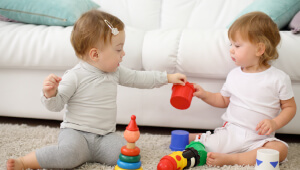Child’s Play


You’ve probably noticed that when two young toddlers play with each other, there’s not too much togetherness going on. Toddlers are more likely to play side-by-side, in what’s known as parallel play. Frequently, around the second year of life, a magical change takes place: Many children begin to play with one another, which is known as interactive play. It’s a time when first friendships are born.
“It’s an exciting transition when they experience play together,” says Barbara Kay Polland, Ph.D., a professor of child development at California State University–Northridge. By playing together, children learn such concepts as sharing, taking turns and cooperation. They entertain and learn from one another.
Don’t expect miracles overnight, though. They may be playmates but they’re still toddlers who have only a rudimentary understanding of such concepts as sharing, teamwork and taking turns.
Below are some strategies for promoting successful playtimes.
- Pick a neutral territory.“Don’t have them play in your child’s bedroom,” suggests Polland. “Because toddlers this age are still so territorial, it can be hard for a child to see another child pulling things off her shelf.” A park, the living room or the kitchen are better venues until the two children are older and accustomed to being together.
- Set out toys with similar, multiple parts.Wanda Celgin of Arnold, Md. is the mother of two toddlers, 29-month-old Alicia and 18-month-old Clay. “They do well with things like big plastic trucks combined with lots of little toy people,” she says. Other activities with enough to go around include coloring, play dough, blocks and outside play.
- Double the fun.To discourage fights during playdates, Polland bought duplicates of inexpensive toys like sand pails and shovels for her toddler. “On my son’s pail I wrote ‘Mark,’ and on the other I wrote ‘My Friend.'” She also bought a second ride-on plastic trike that didn’t have pedals. “With two of the same toy, Mark and a friend didn’t have to take turns. Both children enjoyed playing with ‘twin toys’ and entertained themselves and each other for an hour or more.”
- Encourage taking turns.When Celgin’s children use crayons, she intervenes when one tries to grab the other’s crayon by telling them that they must wait until the child is finished. The crayon is usually then handed over without a fuss. “You have to work with them, but they catch on fast,” she says.


